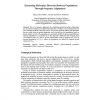Free Online Productivity Tools
i2Speak
i2Symbol
i2OCR
iTex2Img
iWeb2Print
iWeb2Shot
i2Type
iPdf2Split
iPdf2Merge
i2Bopomofo
i2Arabic
i2Style
i2Image
i2PDF
iLatex2Rtf
Sci2ools
ISMDA
2005
Springer
2005
Springer
Extracting Molecular Diversity Between Populations Through Sequence Alignments
The use of sequence alignments for establishing protein homology relationships has an extensive tradition in the field of bioinformatics, and there is an increasing desire for more statistical methods in the data analysis. We present statistical methods and algorithms that are useful when the protein alignments can be divided into two populations based on known features or traits. The algorithms are considered valuable for discovering differences between populations at a molecular level. The approach is illustrated with examples from real biological data sets, and we present experimental results in applying our work on bacterial populations of Vibrio, where the populations are defined by optimal growth temperature, Topt.
ISMDA 2005 | Medical Imaging | Protein Homology Relationships | Sequence Alignments | Statistical Methods |
| Added | 27 Jun 2010 |
| Updated | 27 Jun 2010 |
| Type | Conference |
| Year | 2005 |
| Where | ISMDA |
| Authors | Steinar Thorvaldsen, Tor Flå, Nils Willassen |
Comments (0)

